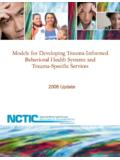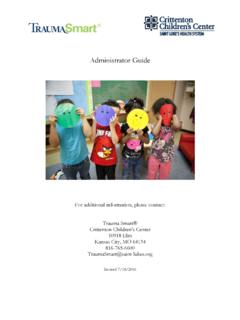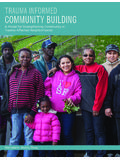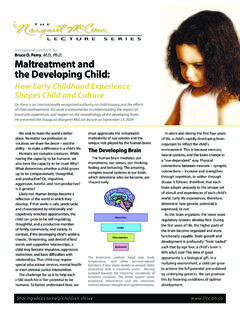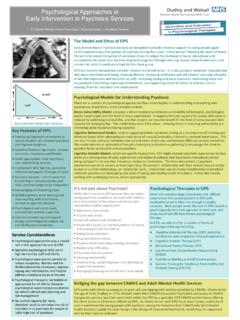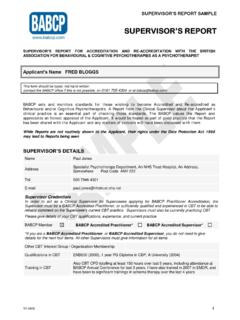Transcription of Innovations in Implementation of Trauma-Informed …
1 Innovations in Implementation of Trauma-Informed Care Practices in Youth Residential Treatment: A Curriculum for Organizational Change Victoria Latham Children in the child welfare system frequently Hummer experience trauma within the caregiving rela- University of South Florida tionship. These traumatic experiences may be compounded by system trauma and place these Nor n Dollard children at high risk of emotional disorders University of South Florida and placement in out-of-home (OOH) men- John Robst tal health treatment programs. This article University of South Florida reviews the literature on trauma and children in the child welfare system and discusses a Mary I. Armstrong study of Trauma-Informed practices in OOH. University of South Florida treatment programs and the curriculum Creat- ing Trauma-Informed Care Environments, which resulted from study findings. Child Welfare Vol. 89, No. 2 79. Child Welfare Vol. 89, No. 2. hildhood traumatic stress refers to both physical and emotional C responses of children to life-threatening events that cause or threaten injury, such as child sexual abuse, physical abuse, or family violence (Child Welfare Collaborative Group, National Child Traumatic Stress Network [NCTSN], and California Social Work Education Center, 2008).
2 The types of trauma prevalent among chil- dren and families in child welfare include abuse and neglect, expo- sure to violence, and exposure to parental substance abuse. Child maltreatment also co-occurs with risk factors within disadvantaged environments, such as neighborhood violence and inadequate com- munity resources (Edleson, 1999; Rudo, Powell, & Dunlap, 1998). As children move through the child welfare and juvenile court systems, they often encounter additional stressful, frightening, and emotionally overwhelming experiences through system-generated trauma (Ryan, Bashant, & Brooks, 2006), such as multiple place- ments and frequent changes in schools and peer groups (Ko, Ford, Kassam-Adams, Berkowitz, Wilson, Wong, Brymer, & Layne, 2008). Because of the increased risk for emotional and behavioral chal- lenges experienced by children in child welfare (Landsverk, Burns, Stambaugh, & Rolls Reutz, 2009), these placement changes often include out-of-home (OOH) mental health treatment programs, including residential treatment programs.
3 Consequently, there are high rates of trauma exposure in the histories of youth in OOH set- tings (LeBel & Stromberg, 2004). The high rate of dependent children and youth in OOH mental health treatment programs, combined with the recognition of the need for trauma -related training and resources from Florida's serv- ice provider community, provided the impetus for evaluating the degree to which Trauma-Informed care was being implemented in Florida's OOH mental health treatment programs. The findings from the eight nominated residential mental health settings in Florida who participated in the assessment were used to develop a comprehensive Acknowledgments: This work was funded in part by the Florida Agency for Health Care Administration, con- tract MED-078. The University of South Florida's Institutional Review Board approved the study described herein. 80. Hummer et al. Child Welfare curriculum that highlights successful Implementation and sustain- ability of cultural change within organizations that are adapting Trauma-Informed and trauma -specific care.
4 This curriculum merges the current research on models of Trauma-Informed care with theories of organizational change and development (Hodges, Hernandez, Nesman & Lipien, 2002) and Implementation research (Fixsen, Naoom, Blas , Friedman, & Wallace, 2005). Background There is a growing recognition that chronic and complex trauma is at the core of many behavioral and psychological disorders of children and adolescents (Cook, Blaustein, Spinnazzola, Van der Kolk, & the Complex trauma Task Force, 2003), and that research-proven practice is essential for e ective treatment of this population. Complex trauma refers to problems from exposure to multiple traumatic events and the resulting short- and long-term e ects of such exposure. This generally occurs within the caregiving system, which suggests that interventions that occur within the context of relationships are the desired avenue for healing (Perry, Pollard, Blakley, Baker, & Vigilante, 1995). Exposure to early, repeated, and multiple episodes of abuse increases the risk for complex trauma , a ecting the self-regulatory, behavioral, and emotional systems of traumatized children (Cook et al.)
5 , 2007). Therefore, the need for intervention within the caregiving relationship also extends to rela- tionships between direct-care sta and children in mental health treat- ment programs. Residential programs that serve traumatized children and youth should be first and foremost a sanctuary with an abun- dance of environmental and relational safeguards to prevent further retraumatization (Bloom, Bennington-Davis, Farragher, McCorkle, Nice-Martin, & Wellbank, 2003). The research literature distinguishes between two types of trauma treatment: trauma -specific and Trauma-Informed . trauma -specific services directly address complex trauma and facilitate the child's recovery through individual or group therapy specifically focusing on trauma recovery; central goals are achieving safety in one's envi- ronment, developing skills in emotion regulation and interpersonal 81. Child Welfare Vol. 89, No. 2. functioning, making meanings about traumatic events, and enhanc- ing resiliency and integration into a social network (NCTSN, 2007).
6 trauma -specific treatment approaches may include such interven- tions as psychological debriefing, psychological education, cognitive behavioral therapy, and psychotropic medication (Cohen, Mannarino, Berliner, & Deblinger, 2000). Trauma-Informed services address the dynamics and impact of complex trauma on youth through a focus on avoiding inadvertently retraumatizing them when providing assistance within the mental health system. For example, in agencies using Trauma-Informed prac- tices, all sta that interact with youth may be trained to recognize and respond therapeutically to manifestations of trauma such as act- ing out behaviors. A Trauma-Informed organizational culture sup- ports and sustains trauma -specific services as they are introduced ( Jennings, 2004, p. 68). Literature on Trauma-Informed care suggests that to implement Trauma-Informed care, there is a need for organizational readiness, assessment, and change (Harris & Fallot, 2001; Rivard, Bloom, McCorkle, & Abramovitz, 2005).
7 Several curricula highlight the principles and elements of Trauma-Informed care within schools, child welfare, juvenile justice, and residential care. The curricula dis- cussed in this article focus specifically on facilitating cultural change within the organization, addressing gaps and barriers, and taking e ective steps based on the science of Implementation (Fixsen et al., 2005). Implementing Trauma-Informed practices is then based on using individualized organizational data to inform planning and Implementation . Case studies that examined organizational factors related to successful Implementation of Trauma-Informed practices at OOH treatment settings in Florida are discussed here. Methods Case Studies Florida has three Medicaid-funded, OOH mental health treatment settings: statewide inpatient psychiatric program (SIPP), therapeu- tic group care (TGC), and therapeutic foster care (TFC). The SIPP. 82. Hummer et al. Child Welfare is a facility-based residential treatment designed for clinically eligi- ble children who are high users of inpatient psychiatric services.
8 TGC. services are community-based psychiatric residential treatment services for youth with emotional and behavioral issues, and TFC. services are intensive treatment services provided to youth with emo- tional and behavioral issues in a licensed therapeutic foster home. Youth served in OOH treatment are more likely to be male, slightly more likely to be white, and on average are 13 14 years old. Typical diagnoses include attention deficit disorders, mood and a ective dis- orders, and disruptive behavior. Through a statewide nomination process, this study identified Florida provider agencies representing three SIPP facilities, two TGC. homes, and two TFC programs that were already using trauma - informed approaches (Armstrong, Dollard, Hummer, Vergon, Robst, Cobb, Clark, Li, & Reyes, 2008). The case study approach addressed whether and how organizational culture in the nominated agencies supported Trauma-Informed practice in addition to the clinical prac- tice elements that specifically address trauma .
9 Findings were based on 75 interviews, 33 clinical record reviews, 12 treatment team obser- vations, and reviews of policy and procedure manuals at 8 sites nom- inated by peers as using Trauma-Informed care practices. The findings from these site visits were analyzed using a trauma - informed framework adapted from the Trauma-Informed program self-assessment scale (Fallot & Harris, 2006), a measure originally developed for use with adult service-system agencies. The measure identifies six domains of Trauma-Informed care based on previous research with women survivors of trauma . These domains reflect pro- gram procedures and settings. This measure was adapted for use with agencies providing residential treatment services to children and youth with permission of the author. Key modifications included the addition of activities specific to residential care, such as transitioning to the next placement, as well as activities specific to children and youth (vs. adult clients), such as the frequency of caregiver involve- ment in treatment planning.
10 Using data collected through interviews, case record reviews, doc- ument reviews, and treatment team observations at the eight study 83. Child Welfare Vol. 89, No. 2. sites, ratings of high, moderate, or low Trauma-Informed care imple- mentation were assigned to agency-level policies and practices. Agencies were assigned ratings in each domain based on the con- sensus score among a team of three reviewers to assure inter-rater reliability. At least two reviewers were present at the site review to record reviews, written treatment team observations, transcribed stakeholder interviews, and copies of policies, procedures, training materials, and formal documents. Case Study Results The results of the site visits identified organizational factors related to successful Implementation of Trauma-Informed care and confirmed the importance of including an organizational self-assessment instru- ment and process in the Trauma-Informed care curriculum. The orga- nizational factors identified from the case studies are summarized under each domain.


